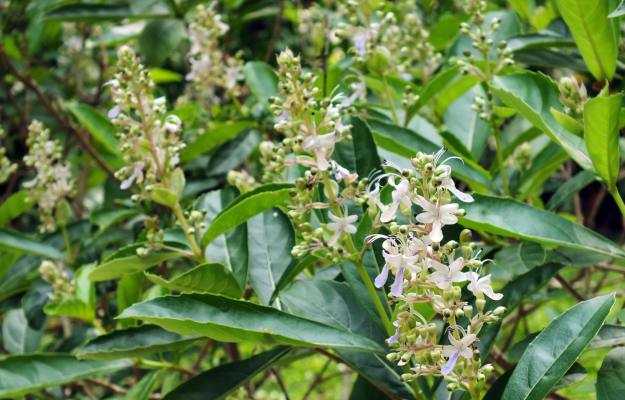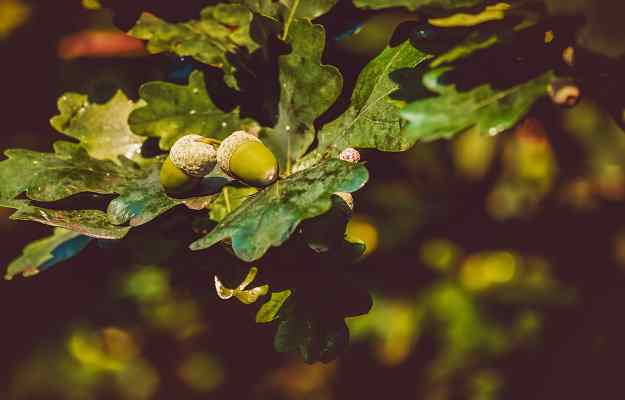Bharangi is said to have been discovered by a sage by the name of Bhrigu, hence the name. Also called bag flower in day-to-day conversations, Bharangi is a woody shrub that grows especially well in a loamy soil. It bears flowers that have a stark resemblance to lotuses and leaves that are between three inches and eight inches long. These flowers, which bloom in the summer months, are bluish-pink in colour. They have a mild fragrance and are edible, as is the rest of the plant. The fruits appear in the rainy season.
Bharangi is a traditional remedy for respiratory problems. It is also said to possess other therapeutic properties, thanks to the presence of certain saponins, flavonoids and phenolics in its roots and leaves especially. Continue reading to find out all there is to know about Bharangi, its uses, side effects and doses.
Basic facts about Bharangi:
- Botanical name: Clerodendrum serratum and Rotheca serrata
- Common name: Glory bower, bag flower, bleeding heart, Cheruthekku
- Family: Verbenaceae
- Sanskrit name: Bharangi
- Native region and geographical distribution: South-East Asia (including India and Sri Lanka), South Africa, Tropical America, Northern Australia
- Parts used: Roots, leaves, bark
- Energetics: Known to pacify Kapha and Vata “doshas”
Bharangi benefits for health
Some of the medicinal properties attributed to Bharangi are as follows :
- Antipyretic: Reduces fever
- Expectorant: Helps to remove excess phlegm
- Anti-inflammatory
- Appetizer: Improves appetite
- Anti-toxic
- Antiseptic
- Astringent
- Styptic: Helps to stop the bleeding from a wound
Indeed, Bharangi was used in folk medicine for a number of ailments as:
- Bharangi leaves were boiled with oil and butter and the ointment was applied for the treatment snakebites in Hoshangabad district of Madhya Pradesh.
- Bharangi roots and bark were used for cough, cold, bronchitis and asthma
- Various parts of the plant were used for reducing inflammation, and improving appetite, dyspepsia and flatulence
- The plant was also used to bring down a fever
- In Karnataka, Bharangi leaves were used in the treatment of bronchial asthma, cough, piles and goitre while the roots were used for accidental wounds by folk medicine practitioners
While researchers have documented these folk medicinal and traditional uses as part of ethnobotany knowledge, scientific studies on most of these purported benefits are still sparse. Read on to know more:
Bharangi for skin
Bharangi is said to be helpful in achieving clearer skin. Applying the juice obtained from the leaves of Bharangi can provide relief from skin diseases as well as boils.
Bharangi for asthma, cold, allergy, tuberculosis
Bharangi is said to be useful in the management of chronic respiratory conditions including asthma. It acts as a mucolytic (breaks down the mucus) and helps in its expulsion from the lungs. It can also be used in the treatment of common cold, rhinitis and tuberculosis.
Bharangi for herpes infection
Herpes simplex virus (HSV) is a group of viruses that cause infections in humans. Of these, HSV can cause cold sores around the mouth and HSV-2 mainly causes a viral STD (sexually transmitted disease)—this condition can be painful. Bharangi’s anti-inflammatory properties are said to ease the symptoms of herpes infection. More research is needed to confirm this and understand the exact mechanism.
Bharangi for headaches
If your head is throbbing after a long day of chaos, Bharangi can come to your rescue. The root powder of Bharangi, when made into a paste and applied to the forehead generously, is said to help in getting relief from mild to intense headaches.
Bharangi for wound healing
As we know, bharangi has anti-inflammatory as well as anti-septic properties. When a paste made of Bharangi leaves is applied on the affected area, it helps in the quick healing of wounds, ulcers and abscesses. If the wound has been infected, it also helps in getting relief from the burning sensation. (READ : Abscess, symptoms, causes)
Bharangi for joint pain
Rheumatoid arthritis, gout or inflammation in the joint can cause immense pain and discomfort. In some cases, it can restrict the person’s ability to move the joint. Local application of bharangi can help in the pacification of this pain. (READ : Joint pain, symptoms, causes)
Bharangi for fever
Ayurveda has celebrated Bharangi for its antipyretic properties. In case of fever, especially malaria fever or hyper-pyrexia, Bharangi can be used to lower the body temperature.
More research is needed on this. It is important to note that this therapy should not be seen as an alternative to a doctor's visit. Rather, it may be seen as a complementary effort for relief, if the doctor says it's okay and that it would not interfere with the malaria treatment he/she has prescribed.
Bharangi for worm infestation
Worm infestations are very common, particularly intestinal worms. A decoction of Bharangi, when consumed regularly, can help in getting rid of the infestation.
Bharangi for lymph node health
Lymphadenopathy is the most common type of condition that affects the lymph nodes, causing them to become swollen or enlarged. A paste of Bharangi leaves is used for relief from this inflammation. (Read more: Swollen lymph nodes, causes, symptoms, prevention, diagnosis, treatment)
Bharangi dosage and Bharangi side effects
There are no known side effects of Bharangi herb when it is taken in the recommended dosage of 3-6 grams.
Find Ayurvedic Doctor in cities
Doctors for Bharangi benefits and side effects

Dr. Ayush Bansal
Ayurveda
2 Years of Experience

Dr. Megha Sugandh
Ayurveda
6 Years of Experience

Dr. Nadeem
Ayurveda
3 Years of Experience














